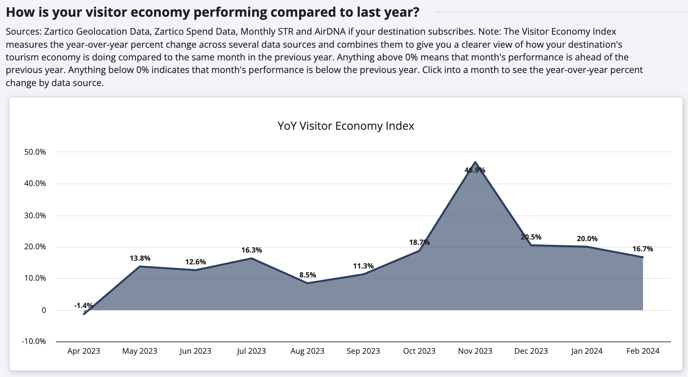The Visitor Economy Index shows how your tourism economy is doing compared to the same month in the previous year.
Making space for the next great thing...
When we developed the Visitor Economy Index (VEI) in 2022, destinations across North America were laser-focused on immediate situational awareness, specifically seeking a clear picture of their community’s pandemic recovery and opportunities to drive demand. Combining multiple visitor economy indicators into a single year-over-year graph provided an at-a-glance way to understand and report on the status of this recovery.
As the travel market has stabilized over the past couple of years, year-over-year differences in the metrics that power the VEI have become less pronounced. And as destinations pivot their focus, we’ve heard feedback from many clients that this insight isn’t as valuable now as it once was.
In response to your feedback and the changing needs of the industry, we have updated the VEI.
At the same time, we have been evolving, working to deliver insights that tell you about the quality — more than the quantity — of your visitation. As you chart a strategic course for the future, the ability to influence quality visits will be vital to cultivating a thriving visitor economy.
This mission was at the heart of our decision to license the largest commercially available set of lodging performance data, and it’s driving our Data Science and Engineering teams as they develop soon-to-launch new overnight visitation metrics.
Stay tuned for more product updates, and reach out to support@zartico.com with any questions.
What is the Visitor Economy Index?
The Visitor Economy Index shows how your tourism economy is doing compared to the same month in the previous year. The Index measures the year-over-year percent change across several data sources, including visitor device count, visitor cardholder count, visitor total spend, hotel occupancy and ADR.
Watch this video for a quick explanation, or read the text below for more details...
Examples of Inputs:
Below you can see and example of the the visitor economy index which shows the % change year-over-year for:
- visitor device count
- visitor cardholder count
- visitor total spend
- hotel demand
- hotel revenue
- short-term rental revenue
Example of What the Visitor Economy Index Looks Like:
The insight is NOT tied to the date range filter. It’s always set to show the months of the year we are in.
You can drill in to a specific month to see the percent change details across all inputs.

*Your data value categories may vary depending on the data set you provide during implementation.
What is it used for?/What question will this answer?
This index will help you understand how your destination is performing across several key indicators. Use this to communicate to stakeholders how your destination's visitor economy is performing year-over-year.
How does it work?
We calculate the percent change across all inputs and then weigh them. Anything above 0 means that performance is ahead of the previous year. Anything below zero indicates that performance is below the previous year.
What data is included in this index?
Visitor device count, visitor cardholder count, visitor total spend, hotel demand and revenue, and short-term rental revenue.
Versions of Visitor Economy Index
Since this index is dependent on data sets you bring in, there are versions of the Visitor Economy Index that compare similar sets of data across all partners. It all depends on what data you subscribe to. For example, you might subscribe to STR but don't receive Demand or Revenue data as part of your subscription. In that case, your index would include Occupancy and ADR instead.
How is this index calculated?
Each data set is weighted depending on the number of data sets brought in by the partner and calculated to give an overall percentage.